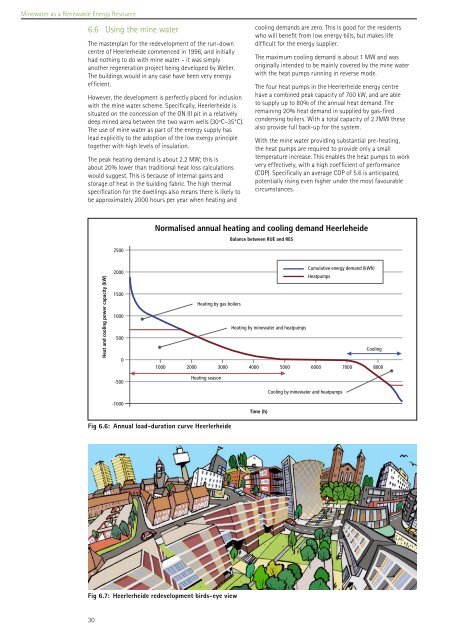Mine water as a Renewable Energy Resource - Promoscene
Mine water as a Renewable Energy Resource - Promoscene
Mine water as a Renewable Energy Resource - Promoscene
Create successful ePaper yourself
Turn your PDF publications into a flip-book with our unique Google optimized e-Paper software.
<strong>Mine</strong><strong>water</strong> <strong>as</strong> a <strong>Renewable</strong> <strong>Energy</strong> <strong>Resource</strong><br />
6.6<br />
Using the mine <strong>water</strong><br />
The m<strong>as</strong>terplan for the redevelopment of the run-down<br />
centre of Heerlerheide commenced in 1996, and initially<br />
had nothing to do with mine <strong>water</strong> – it w<strong>as</strong> simply<br />
another regeneration project being developed by Weller.<br />
The buildings would in any c<strong>as</strong>e have been very energy<br />
efficient.<br />
However, the development is perfectly placed for inclusion<br />
with the mine <strong>water</strong> scheme. Specifically, Heerlerheide is<br />
situated on the concession of the ON III pit in a relatively<br />
deep mined area between the two warm wells (30ºC–35°C).<br />
The use of mine <strong>water</strong> <strong>as</strong> part of the energy supply h<strong>as</strong><br />
lead explicitly to the adoption of the low exergy principle<br />
together with high levels of insulation.<br />
The peak heating demand is about 2.2 MW; this is<br />
about 20% lower than traditional heat loss calculations<br />
would suggest. This is because of internal gains and<br />
storage of heat in the building fabric. The high thermal<br />
specification for the dwellings also means there is likely to<br />
be approximately 2000 hours per year when heating and<br />
Heat and cooling power capacity (kW)<br />
2500<br />
2000<br />
1500<br />
1000<br />
500<br />
0<br />
-500<br />
-1000<br />
Normalised annual heating and cooling demand Heerleheide<br />
Fig 6.6: Annual load-duration curve Heerlerheide<br />
Fig 6.7: Heerlerheide redevelopment birds-eye view<br />
30<br />
Heating by g<strong>as</strong> boilers<br />
Balance between RUE and RES<br />
1000 2000 3000 4000 5000 6000 7000 8000<br />
Heating se<strong>as</strong>on<br />
cooling demands are zero. This is good for the residents<br />
who will benefit from low energy bills, but makes life<br />
difficult for the energy supplier.<br />
The maximum cooling demand is about 1 MW and w<strong>as</strong><br />
originally intended to be mainly covered by the mine <strong>water</strong><br />
with the heat pumps running in reverse mode.<br />
The four heat pumps in the Heerlerheide energy centre<br />
have a combined peak capacity of 700 kW t and are able<br />
to supply up to 80% of the annual heat demand. The<br />
remaining 20% heat demand in supplied by g<strong>as</strong>-fired<br />
condensing boilers. With a total capacity of 2.7MW these<br />
also provide full back-up for the system.<br />
With the mine <strong>water</strong> providing substantial pre-heating,<br />
the heat pumps are required to provide only a small<br />
temperature incre<strong>as</strong>e. This enables the heat pumps to work<br />
very effectively, with a high coefficient of performance<br />
(COP). Specifically an average COP of 5.6 is anticipated,<br />
potentially rising even higher under the most favourable<br />
circumstances.<br />
Heating by mine<strong>water</strong> and heatpumps<br />
Time (h)<br />
Cumulative energy demand (kWh)<br />
Heatpumps<br />
Cooling by mine<strong>water</strong> and heatpumps<br />
Cooling


